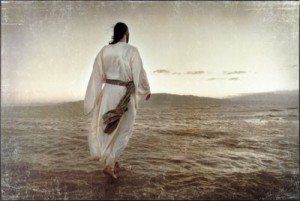When you are one with Jesus, you do what he does!
The gospel narrative of the 18th Sunday in Cycle A is about feeding the five thousand with five loaves and two fish. The story in the gospel reading of today is what follows immediately after that feeding. To understand the meaning of the reading of today, we need to ask an intriguing question: in whose hands did the miracle of the loaves really take place? What do I mean? Did Jesus take the loaves and the fish, put a veil around them, and say the magic words, ‘Abracadabra’ (by the way, this is Aramaic – the mother-tongue of Jesus, the equivalent of the Indian version, ‘zee-boom-bah’), pull away the veil, and behold, an abundance of bread and fish!
No! That would be magic. And Jesus was not a magician – though some people expect Jesus to be one, even today. On the other hand, what actually happened was, “taking the five loaves and the two fish he looked up to heaven, and blessed, and broke and gave the loaves to the disciples, and the disciples gave them to the crowds” (Mt 14:19). Yes, the disciples gave them to the crowds, and the miracle happened even as they gave out the loaves. The miracle happened in the hands of the disciples.
Were not the disciples able to calm the sea? After the miracle of loaves, Jesus “made the disciples get into the boat and go before him to the other side” (Mt 14:22). What is Jesus up to – isolating himself from the community of disciples? Sure enough, the boat struggles “beaten by the waves; for the wind was against them” (Mt 14:24). But there was no need for the disciples to panic. The miracle of loaves had taken place in their hands, they had received the bread – blessed and broken – and Jesus was with them. They just had to believe. As if this was not sufficient, Jesus would walk on the water to show that he is still in control. But they panic even at the sight of Jesus. “They were terrified, saying, “It is a ghost!” And they cried out for fear” (Mt 14:26).
The Jews were basically nomadic pastoralists. They were not seafarers. The inhabitants around Galilee had, in time, ventured into this lake – to the ridicule of the Jews of Judea – and yet their relationship with the ‘waters of the sea’ still remained mystery-laden. They believed that the restless ‘waters’ of the sea was the home to monsters and ghosts. Hence, it was also a symbol of evil. Jesus walking on the water was a didactic-action; he was teaching them by his action that he was in control of evil that threatens them.
You too can conquer evil! Peter conditionally recognises this. Only conditionally: “Lord, if it is you, bid me come to you on the water” (Mt 14:28). As if to ask, if you are truly with me, is it also possible for me to conquer evil? He puts Jesus to test. And Jesus said, “Come!” (Mt 14:29). What follows is a drama of the test of the faith of Peter. When Peter is overcome with the fear of the wind, he sinks. He had not understood the miracle of the loaves, as the Gospel of Mark would have it (Mk 6:52). Interestingly, even in that sinking Peter has a grain of faith: Lord, save me, he cries out. Then there is a happy ending to the story: “And those in the boat worshipped him, saying, “Truly you are the Son of God” (Mt 14:33).
Today, Jesus invites me to come out of the security of my boat, to move towards him in faith, with a willingness to overcome evil that is within me and all about me. I am not alone. He is with me. With him near me, there is multiplication of the loaves and there is calming of the sea.
